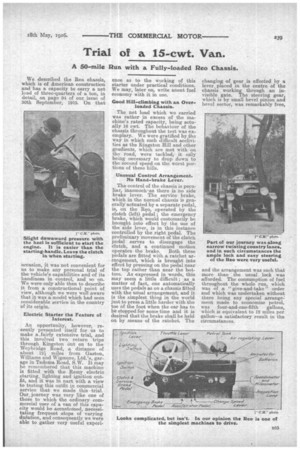Trial of a 15-cwt. Van.
Page 17

If you've noticed an error in this article please click here to report it so we can fix it.
A 50-mile Run with a Fully-loaded Reo Chassis.
We described the Reo chassis, which is of American construction and has a capacity to carry a net load of three-quarters of a ton, in detail, on page 94 of our issue of 30th September, 1915. On that
occasion, it was not convenient for us to make any personal trial of the vehicle's capabilities and of its handiness in control, and so on. We were only able then to describe it from a constructional point of view, although we were well aware i that t was a model which had seen considerable service in the country of its origin.
Electric Starter the Feature of Interest.
An opportunity, however, recently presented itself for us to make a .fairly extensive trial, and this involved two return trips through. Kingston out on to the Weybridge Road, a distance of about 121 miles from Gaston, Williams and Wigtnore, Ltd.',s, garage in Tadema Road, S.W. It may be remembered that this machine is fitted with the Remy electric starting, lighting and ignition outfit, and it was in part with a view to testing this outfit in commercial service that we made this • trial. Our journey was very like one of those to which the ordinary commercial user of a van of this capacity would be accustomed, necessitating frequent stops of varying duration, and consequently we were able to gather very useful experi
ence as to the working of this starter under practical conditions. We may, later on, write anent fuel economy with it in use.
Good Hill-climbing with an Overloaded Chassis.
The net load which we carried was rather in excess of the machine's rated capacity, being actually 16 cwt. The behaviour of the chassis throughout the test was exemplary. We were gratified by the way in which such difficult acclivities as the Kingston Hill and other gradients, which are met with on the road, were tackled, it only being necessary to drop down to the second speed on the worst portions of these hills.
Unusual Control Arrangement. No Hand-brake Lever.
The control of the chassis is peculiar, inasmuch-as there is no side brake lever. The service brake, which in the normal chassis is generally actuated by a separate pedal, is on the Rgo, operated by the dutch (left) pedal ; the emergency brake, which. would customarily be brought into effect by the use of the side lever, is in this instance controlled by the right pedal. The preliminary movement of the clutch pedal serves to disengage the clutch, and a continued motion operates the brake. Both these
pedals are fitted with a ratchet arrangement, which is brought into
effect by pressing on the pedal near the top rather than near the bottom. As expressed in words, this may seem a little difficult ; as a matter of fact, one automatically uses the pedals as on a chassis fitted with the usual arrangement, and it is the simplest thing in the world just to press a, little harder with the toe of the foot when the car has to be stopped for some time and it is desired that the brake shall be held on by means of the ratchet. The
changing of gear is effected by a lever_ placed in the centre of the chassis working through an invisible gate. The steering gear, which is by small bevel pinion and bevel sector, was remarkably free, and the arrangement was such that more than the usual lock was afforded. The consumption of fuel throughout the whole run, which was of a, "give-and-take" order and which was undertaken without there being any special arrange-: merit made to economise petrol, was four-and-one-fifth gallons, which is equivalent to 12 miles per gallon—a satisfactory result in the circumstances.




















